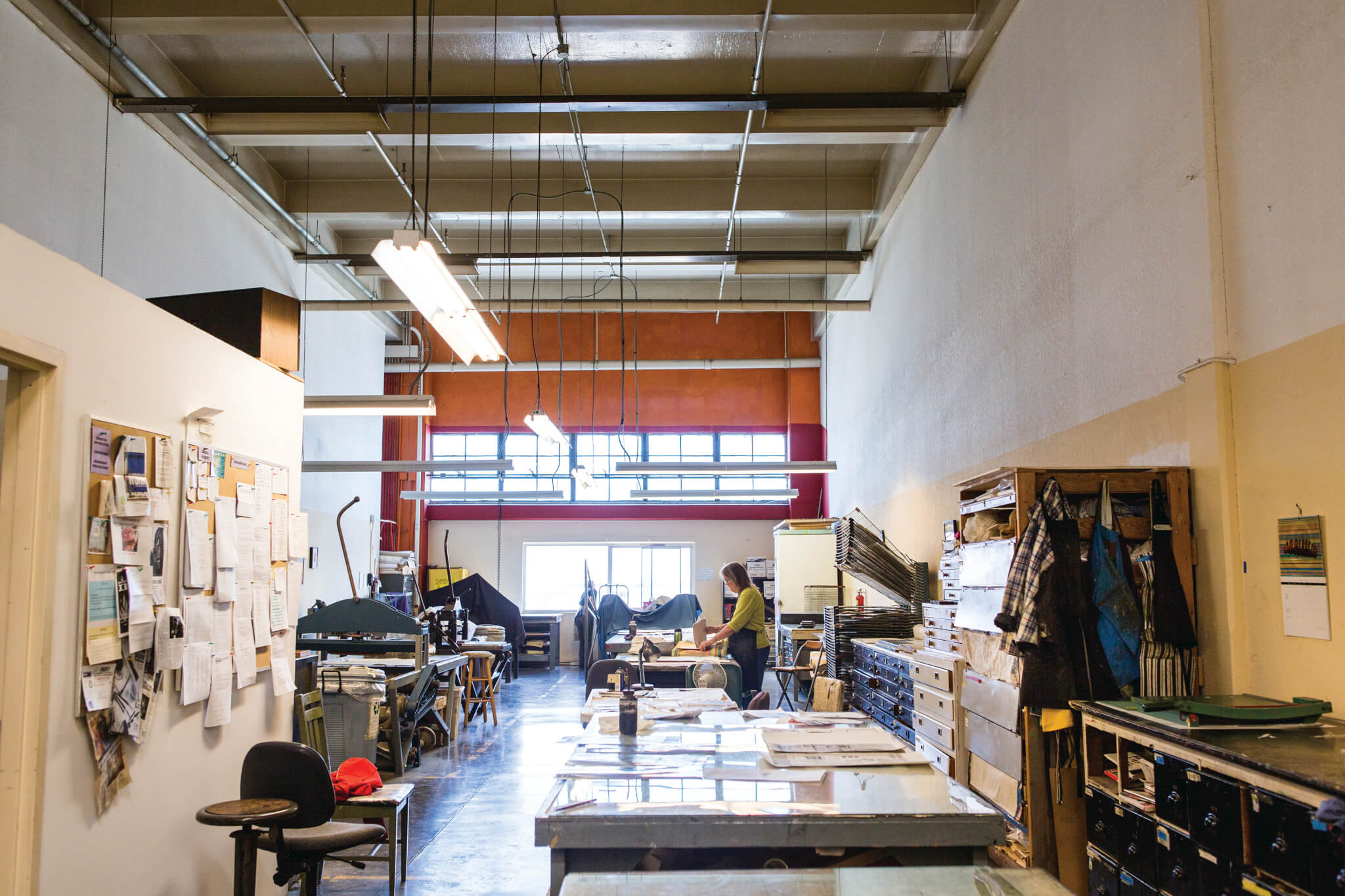Behind a set of bright yellow doors on the third floor of the American Industrial Center (AIC) is a room filled with printmaking equipment: four etching presses, two litho presses, a letter press, an aquatint box, silkscreens and a hot plate. These are just some of the tools printmakers at the Graphic Arts Workshop use to partice their craft.
Graphic Arts Workshop is a printmaking cooperative where artists have access to what Workshop member Gail Morrison called “insanely expensive” equipment. Printmaking is often considered arcane, increasingly overlooked with the advent of new digital tools and technology. But according to Morrison there’s still an interest in using different presses to create something. “People are getting more into this hands-on kind of thing,” she said.
Morrison, a retired gardner who lives in the City of Richmond, found her place at the Workshop about six years ago. “All my life I said I wish I had become an artist,” she said. She finally realized that her artist life wasn’t going to appear out of nowhere. She started taking monoprint classes since they had “always caught my eye,” she said. While learning that printing skill she was taken by the art of etching, which involves using acid to “etch” designs into metal plates. She was hooked. She took classes at Diablo Valley College in Pleasant Hill and at the Civic Arts Education program in Walnut Creek.
“Etching appeals to the nerd in me,” Morrison said, describing the process of designing, carving into the resistance, using ferric chloride to burn or “etch” the design onto a zinc or other metal plate and then inking the design for the final printing stage. Even with an established way to create prints, Morrison enjoys the opportunity to discover something new; such as the time she used tape to hold a piece down, saw the residual print it left behind and incorporated it into the work.
To become a Workshop member takes more than just a passing interest in printmaking. “Everybody is pretty serious,” Morrison said, “It’s expensive to be fooling around.” A prospective artist has to show their portfolio and demonstrate their skill with the tools and equipment before being accepted into the cooperative. GAW now boasts about 30 members, who pay $100 in monthly dues. Membership is always in flux, with one or two people leaving every year and new members joining. Members have unlimited 24/7 access to the workshop.
A truly cooperative space, the Workshop has no paid staff. Everyone is responsible for the equipment and workspace. Morrison is part of the elected “council,” a group of members who meet monthly as a management committee. The Workshop offers printing equipment, some basic tools and supplies, along with storage space, drying racks, a library and a printmaking community. Members hail from around the City, the East Bay and Marin County.
The Workshop’s roots go back to 1952 and are political. Founded at the art department at the City’s defunct California Labor School, the Workshop continued even after the school closed in 1957. The closure came after accusations of Communists attending and working at the school during the McCarthy era. Since then the Workshop has lost its strong political leanings. Morrison lamented that the group’s history is slowly fading as new generations of artists join.
The longest standing member is Alice Gibbons, who after 40 years at the Workshop serves as a de facto historian about all things printmaking in the Bay Area. She specializes in intricate etchings.
The Workshop moved to the AIC building around 2000. The space features an East-facing view of overhead wires, the Bay and far-off Oakland hills. The nonprofit was previously located in the Richmond District, and had moved around the City in the years since leaving the Callifornia Labor School. Many famous printmakers have passed through the Workshop. Among them are James Groleau, whose work is displayed at the Legion of Honor museum and is known for his mezzotints; and deceased Emmy Lou Packard.
During an afternoon visit to the cooperative Mary Huizinga showed off the letterpress. She’s been dubbed by other members as “queen of the letterpress.” She considers use of the machine to print typography and imagery onto paper a “craft more than an art.” Like all the equipment at the Workshop, the letter press is mostly human-powered. “It’s very tiring to do more than 25 (prints),” Huizinga said.
Meanwhile, Melanie Dorson was using one of the etching presses to print six circular designs she’ll fold into pages of a small book. As she rolled her special ordered Italian paper through the press she said, “This is basically what Rembrant did; he didn’t have a computer,” referring to the famous 17th-century Dutch artist’s self-portraits. Morrison recalled her first time spinning the wheel of the press as Dorson works, “It was such a thrill.”
Last fall, nine Workshop artists participated in ArtSpan’s San Francisco Open Studios. The Workshop was open and the public was able to catch a glimpse of some of the only printmaking, woodcutting, and screenprinting that takes place in the Bay Area. Dorson and Morrison were two of the artists presenting their work. According to Morrison, although there are few printmaking-only exhibits, many members show their pieces at art shows throughout the region.
For Morrison the hidden appeal of printmaking is waiting to be discovered. “Prinkmaking is not in the forefront of people’s minds,” she said. She listed oil painting or sculpture as more popular art forms, but that doesn’t detract from the work she and other members do. She also doesn’t considered herself retired. Since joining the Workshop, she said with a smile, “I haven’t worked as hard in my life.”
Graphic Arts Workshop is located at 2565 Third Street, Number 305. 285.5660. graphicartsworkshop.org.


